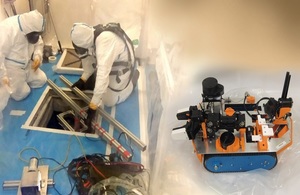News story
A robot has successfully surveyed an underground radioactive ventilation duct in Dounreay’s redundant laboratories.

Dounreay Site Restoration Ltd (DSRL) and the Robotics and Artificial Intelligence in Nuclear (RAIN) Hub are working together to develop a robot capable of accessing areas that are inaccessible or unsafe for humans to work in. The RAIN Hub is a consortium of universities led by the University of Manchester.
In 2020 a group of engineers from RAIN brought a small surveying remotely operated vehicle equipped with sensors, cameras and a manipulator ‘arm’ to Dounreay. Initial trials in an inactive building provided useful information, and a limited survey in the laboratories took place last year.
As a result of this field research, a second generation robot called Lyra was developed, with an improved package of surveying measures including LIDAR (a detection system similar to radar, but which uses lasers), multiple angle cameras, radiation probes and the ability to take swabs using the manipulator arm.
In February, the robot returned to carry out a survey of the 140m long underfloor duct which runs under the central corridor between the laboratories, providing useful information that will help to solve the challenge of decommissioning it.
DSRL Project Manager Jason Simpson said:
Now the characterisation survey is complete we have built up a very comprehensive picture of the duct, which will help us make informed decisions on how the duct should be decommissioned.
RAIN Hub Director Barry Lennox added:
We wanted to demonstrate that the robot could be used successfully in active areas. We added fail safe devices, including a remote “reboot” switch, and a winch to enable us to physically retrieve the robot if it got stuck on the debris in the duct. The survey has demonstrated Lyra’s reliability in active areas.
Published 31 March 2022
Follow this news feed: HM Government





